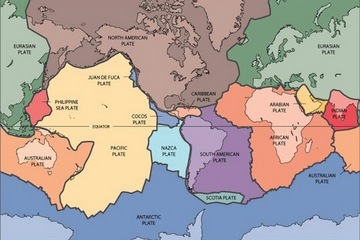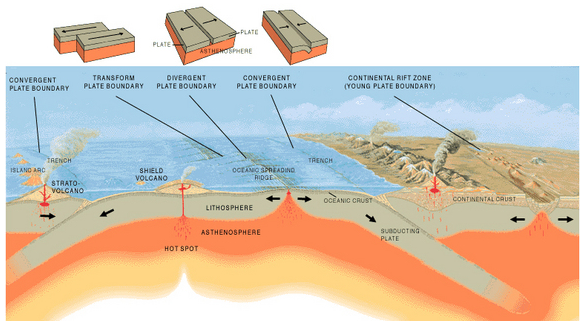Plate tectonics is the theory that Earth’s outer shell is divided into several plates that glide over the mantle, the rocky inner layer above the core. The plates act like a hard and rigid shell compared to Earth’s mantle. This strong outer layer is called the lithosphere.
Developed from the 1950s through the 1970s, plate tectonics is the modern version of continental drift, a theory first proposed by scientist Alfred Wegener in 1912. Wegener didn’t have an explanation for how continents could move around the planet, but researchers do now. Plate tectonics is the unifying theory of geology, said Nicholas van der Elst, a seismologist at Columbia University’s Lamont-Doherty Earth Observatory in Palisades, New York.

Tectonic plates of the Earth.
The driving force behind plate tectonics is convection in the mantle. Hot material near the Earth’s core rises, and colder mantle rock sinks. “It’s kind of like a pot boiling on a stove,” Van der Elst said. The convection drive plates tectonics through a combination of pushing and spreading apart at mid-ocean ridges and pulling and sinking downward at subduction zones, researchers think. Scientists continue to study and debate the mechanisms that move the plates.
Mid-ocean ridges are gaps between tectonic plates that mantle the Earth like seams on a baseball. Hot magma wells up at the ridges, forming new ocean crust and shoving the plates apart. At subduction zones, two tectonic plates meet and one slides beneath the other back into the mantle, the layer underneath the crust. The cold, sinking plate pulls the crust behind it downward.
Plate Boundaries
Subduction zones, or convergent margins, are one of the three types of plate boundaries. The others are divergent and transform margins.
At a divergent margin, two plates are spreading apart, as at seafloor-spreading ridges or continental rift zones such as the East Africa Rift.
Transform margins mark slip-sliding plates, such as California’s San Andreas Fault, where the North America and Pacific plates grind past each other with a mostly horizontal motion.

The main types of plate boundaries
As the continents jostle around the Earth, they occasionally come together to form giant supercontinents, a single landmass. One of the earliest big supercontinents, called Rodinia, assembled about 1 billion years ago. Its breakup is linked to a global glaciation called Snowball Earth.
The essence of plate tectonic theory is that the plates (ocean basins plus or minus continents) slide around over the earth surface, interacting as they do at the plate boundaries. Thus, any time there is a divergent plate boundary where two plates are separating, there must be a convergent plate boundary (subduction zone) where the earth comes together again. And convergent boundaries always, eventually, lead to collisions between continents, or continents and terranes (island arcs plus or minus microcontinents).

